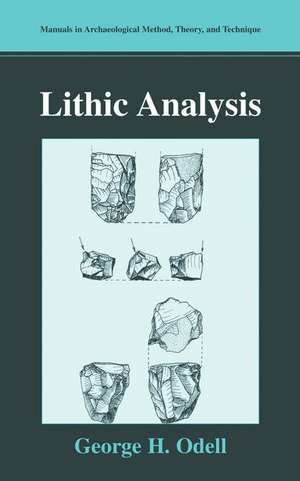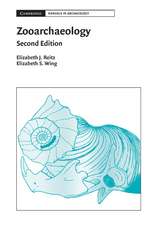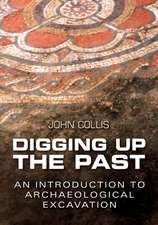Lithic Analysis: Manuals in Archaeological Method, Theory and Technique
Autor George H. Odellen Limba Engleză Paperback – 31 dec 2003
| Toate formatele și edițiile | Preț | Express |
|---|---|---|
| Paperback (1) | 420.97 lei 43-57 zile | |
| Springer Us – 31 dec 2003 | 420.97 lei 43-57 zile | |
| Hardback (1) | 429.99 lei 43-57 zile | |
| Springer Us – 31 dec 2003 | 429.99 lei 43-57 zile |
Preț: 420.97 lei
Nou
Puncte Express: 631
Preț estimativ în valută:
80.58€ • 87.56$ • 67.73£
80.58€ • 87.56$ • 67.73£
Carte tipărită la comandă
Livrare economică 21 aprilie-05 mai
Preluare comenzi: 021 569.72.76
Specificații
ISBN-13: 9780306480683
ISBN-10: 0306480689
Pagini: 262
Ilustrații: XV, 262 p.
Dimensiuni: 152 x 229 x 15 mm
Greutate: 0.41 kg
Ediția:1st ed. 2004. Corr. print. 2003
Editura: Springer Us
Colecția Springer
Seria Manuals in Archaeological Method, Theory and Technique
Locul publicării:New York, NY, United States
ISBN-10: 0306480689
Pagini: 262
Ilustrații: XV, 262 p.
Dimensiuni: 152 x 229 x 15 mm
Greutate: 0.41 kg
Ediția:1st ed. 2004. Corr. print. 2003
Editura: Springer Us
Colecția Springer
Seria Manuals in Archaeological Method, Theory and Technique
Locul publicării:New York, NY, United States
Public țintă
GraduateCuprins
1. History Of Stone Tool Research.- Procurement.- Tool Manufacture.- Assemblage Variability.- Tool Use.- Behavioral Questions.- Perspectives.- 2. Procurement.- Formation Of Rock.- Igneous Rocks.- Sedimentary Rocks.- Metamorphic Rocks.- Summary.- Geomorphic Processes.- Defining The Problem.- Is This Material Local?.- What is the Source of the Material?.- Visual Characterization.- Hand Specimens.- Petrographic Techniques.- Geochemical Techniques.- Neutron Activation Analysis.- X-Ray Fluorescence Analysis.- PIXE and Similar Techniques.- Other Instrumental Types of Analysis.- General Remarks.- 3. Tool Manufacture.- Fracture Mechanics.- General Principles.- Types of Fracture.- Fracture Features.- Types Of Flaking And Flakers.- Percussion Flaking.- Pressure Flaking.- Primary And Secondary Modification.- Primary Modification.- Secondary Modification.- Ground Stone.- Manufacture-Ground Specimens.- Use-Ground Specimens.- Analyzing Ground Stone Tools.- 4. Assemblage Variability.- Detecting Vectors Of Information.- Raw Material.- Technology: Basic Partitioning.- Technology: Distinguishing Trajectories.- Morphology: Characterizing Shape.- Function.- Comparing Assemblages.- Comparing Class Structure.- Comparing Specific Classes.- Analyzing Unretouched Debris.- Individual Flake Analysis.- Mass Analysis.- Summary.- 5. Toolfunction.- Use-Wear Analysis.- Background.- Techniques.- Summary.- Residue Analysis.- Plant Remains.- Blood Residues.- Summary.- 6. Ecountering Pehistoric Bhavior.- Subsistence.- Food Procurement.- Food Processing.- Shelter, Facilities And Clothing.- Structures and Facilities.- Clothing.- Organization Of Mobility And Technology.- Tool Design.- Raw Material Procurement, Supply, and Use.- Complex Societies.- Production of Surplus Goods.- Material Replacement.- Concluding Remarks.- References.
Caracteristici
2005 SAA Award for Excellence in Archaeological Analysis
























